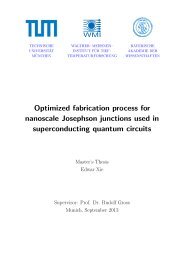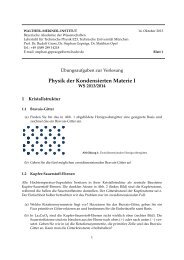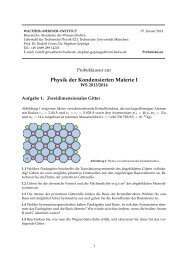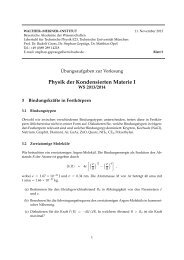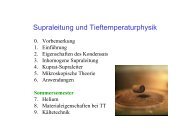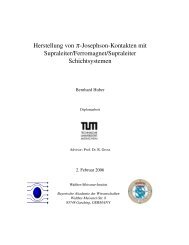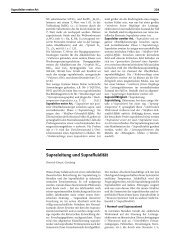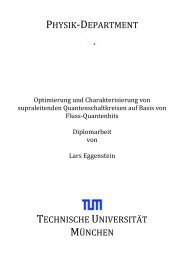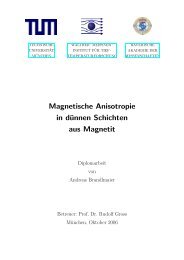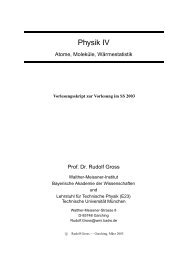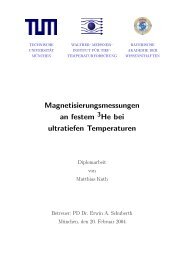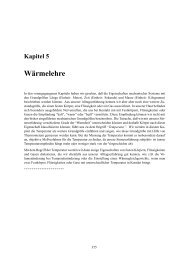Surface magneto-plasmons in magnetic multilayers - Walther ...
Surface magneto-plasmons in magnetic multilayers - Walther ...
Surface magneto-plasmons in magnetic multilayers - Walther ...
Create successful ePaper yourself
Turn your PDF publications into a flip-book with our unique Google optimized e-Paper software.
Section 2.2<br />
Dispersion relation 7<br />
where i represents the layer, the metal (1) and the dielectric (2). In the situation<br />
discussed here Ey can aga<strong>in</strong> without any loss of generality treated as zero.<br />
Furthermore, the <strong>magnetic</strong> field must be perpendicular to the electric field, the mag-<br />
netic field has only a component <strong>in</strong> y-direction<br />
H (i) (r, t) =<br />
⎛<br />
⎜<br />
⎝<br />
0<br />
H (i)<br />
y<br />
0<br />
⎞<br />
⎟<br />
⎠ e i(k(i) x x − ωt) ∓ik<br />
e (i)<br />
z z<br />
(2.4)<br />
Here, the − sign <strong>in</strong> the exponent of the evanescent part (e ∓ik(i)<br />
z z )is valid for the metal<br />
(z < 0) and the + sign for the dielectric (z > 0). It has to be denoted that the<br />
surface <strong>plasmons</strong> propagate <strong>in</strong> positive and negative x-directions. However, s<strong>in</strong>ce<br />
both directions are symmetrical only the positive direction is considered, i.e. kx > 0.<br />
Moreover, as the <strong>in</strong>terface lies at z = 0 it is assumed that kz > 0 for both directions<br />
of z.<br />
To get the dispersion relation for surface <strong>plasmons</strong> the fact is used that both the<br />
electric (Eq. (2.3)) and <strong>magnetic</strong> field (Eq. (2.4)) have to fulfil the Maxwell equations<br />
<strong>in</strong> vacuum [24].<br />
∇ × E (i)<br />
= − ∂B(i)<br />
∂t<br />
∇ × H (i) = ∂D(i)<br />
∂t<br />
= −µ0µ (i) ∂H(i)<br />
∂t<br />
(i) ∂E(i)<br />
= ε0ε<br />
∂t<br />
(2.5)<br />
(2.6)<br />
ε0ε (i) ∇E (i) = ∇D (i) = 0 (2.7)<br />
µ0µ (i) ∇H (i) = ∇B (i) = 0 (2.8)<br />
with ε0 and µ0 be<strong>in</strong>g the dielectric and <strong>magnetic</strong> permeability <strong>in</strong> vacuum and ε (i) and<br />
µ (i) be<strong>in</strong>g the dielectric and <strong>magnetic</strong> permeability <strong>in</strong> a medium i. The solutions have<br />
to satisfy the cont<strong>in</strong>uity conditions at the <strong>in</strong>terface.<br />
E (1)<br />
x = E (2)<br />
x<br />
H (1)<br />
x = H (2)<br />
x<br />
(2.9)<br />
(2.10)<br />
ε (1) E (1)<br />
z = ε (2) E (2)<br />
z . (2.11)



